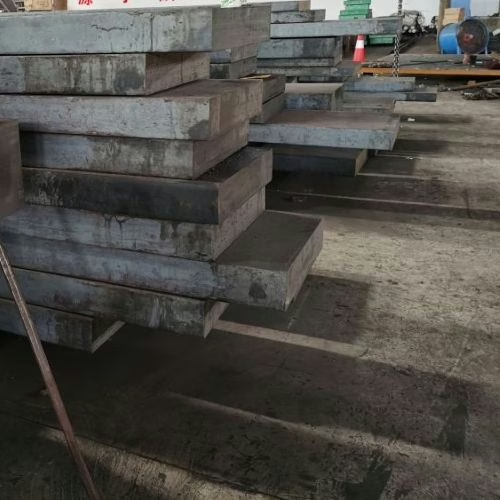42CrMo4 steel is a widely used medium-carbon low-alloy steel, often considered a standard against which other ultrahigh-strength steels are compared. It is known for its deep hardenability, high strength, and good toughness.
1. 42CrMo4 Steel Composition1
| C | Si | Mn | P | S | Cr | Mo | Ni | V |
| 0.38-0.45 | 0.17-0.37 | 0.50-0.80 | ≤0.035 | ≤0.035 | 0.90-1.20 | 0.15-0.25 | ≤0.30 | ≤0.06 |
2. 42CrMo4 Steel Equivalent Grades
- EN: 42CrMo4 (Material No.: 1.7225)
- ISO: 42CrMo4
- ASTM/AISI (USA): 4140 (G41400) and 4142 (G41420)
- JIS (Japan): SCM440 / SCM445
- GOST (Russia): 38XM
- DIN (Germany): 42CrMo4
- BS (UK): 42CrMo4 / 708M40
- NF (France): 42CrMo4
- GB/T (China): 42CrMo (A30422) / 42CrMoH (A30425)
3. Heat Treatment of 42CrMo4 Steel
42CrMo4 steel is a heat-treatable material, and its properties are highly dependent on the specific heat treatment process. It can be supplied in a pre-hardened state.
- 42CrMo4 QT (Quenching & Tempering). The standard quenching and tempering process includes heating to 850-870°C, oil quenching, and then tempering at 500-600°C for 2 hours to obtain a hardness of 28-35 HRC.
- Annealing. Hold at 830-850°C for 3-4 hours, then cool in the furnace to 500°C, followed by air cooling, resulting in a final hardness of ≤217 HBW. For softening annealing, heating to 740-800°C, cooling in the furnace at 15°C/h to 550°C, then air cooling.
- Normalizing. Hold at 870-880°C for 1-2 hours, then cool naturally, resulting in a final hardness of ≤255 HBW.
- High-temperature tempering. Temper at 680-700°C for 2-3 hours, then cool in the furnace to 500°C, followed by air cooling, resulting in a final hardness of ≤217 HBW.
- Stress Relief Treatment. After rough machining, it is recommended to heat to 530°C, hold for 2 hours, and then cool in air.

Please fill out the following contact form to get the best quotation for 42CrMo4 Steel!
4. Mechanical Properties
In the quenched and tempered (Q+T) state, 42CrMo4 delivers excellent mechanical performance. Typical values after oil quenching (850°C) and tempering (580°C) can include:
- Tensile Strength (Rm): ≥ 1100 MPa
- Yield Strength (ReL): ≥ 950 MPa
- Elongation (A): ≥ 12%
- Impact Toughness (KV/KU or aK): Values depend on test method, but good toughness is characteristic (e.g., ≥ 80 J/cm²).
Remember, final properties depend directly on the specific heat treatment parameters used.
5. Applications
- Machine Building: Highly stressed parts like gears, shafts, axles, connecting rods, crankshafts, and high-strength bolts.
- Tooling: Large and medium-sized plastic molds, mold frames, forging dies (depending on application demands), and cold heading dies.
- Other: Large volume gas cylinders and components requiring high fatigue strength.
- ASM International. (1991). ASM Handbook, Volume 4: Heat Treating (p. 700). ASM International. ↩︎
FAQ
AISI/SAE 4140 (USA).
UNS G41400 (USA).
JIS SCM440 or SCM440H (Japan).
BS 708M40 or 709M40 (UK). It also has a BS 970 equivalent of 708A42 (En19C).
AFNOR 42CD4 (France).
ISO 42CrMo4.
42CrMo4 is a medium-carbon alloy steel, specifically a chromium-molybdenum (Cr-Mo) steel. It is known as a heat-treatable steel, meaning its mechanical properties can be enhanced through processes like quenching and tempering. It typically has good overall mechanical properties, including strength and toughness.
Yes, 42CrMo4 has been listed with a British Standard (BS) equivalent of 970 708A42 (En19C), suggesting it is equivalent or a very close match to EN19.
Yes, 42CrMo4 (DIN designation) is widely considered equivalent to AISI/SAE 4140 steel (USA). Their chemical compositions are very similar, particularly in carbon, chromium, and molybdenum content.
No, 42CrMo4 is not classified as mild steel. Mild steels are typically low-carbon steels (1xxx series). 42CrMo4 is a medium-carbon alloy steel, with a carbon content typically ranging from 0.38% to 0.45%. Medium-carbon steels are distinct from low-carbon (mild) steels due to their higher carbon content and ability to be heat-treated for strength.
DIN 42CrMo4 (Germany).
JIS SCM440 or SCM440H (Japan).
ISO 42CrMo4.
BS 708M40 or 709M40 (UK), and 708A42 (En19C).
Yes, 42CrMo4 can rust. It is an alloy steel, not a stainless steel. While it contains chromium (0.90-1.20%), this amount is generally not sufficient to make it “stainless” (which typically requires a minimum of 11.5-13% chromium to be classified as stainless). Therefore, it will corrode, or rust, in certain environments.
4140 steel is generally considered the higher-strength option compared to 4130 steel. This is due to its slightly higher carbon content (4140: 0.38-0.43% C vs. 4130: 0.28-0.33% C) and often higher manganese content.
4140 is a type of steel, which is an alloy primarily composed of iron with carbon and other alloying elements like chromium and molybdenum. Aluminum, on the other hand, is a non-ferrous metal that is significantly lighter than steel. They are fundamentally different materials with distinct properties and applications.
Get a Competitive Quote for 42CrMo4 Steel
With over 20 years of forging expertise, Aobo Steel is your trusted partner for high-performance 42CrMo4 steel. We provide not just materials, but solutions. Leverage our deep industry knowledge and reliable supply chain for your project’s success.
✉ Contact us by filling out the form below.

